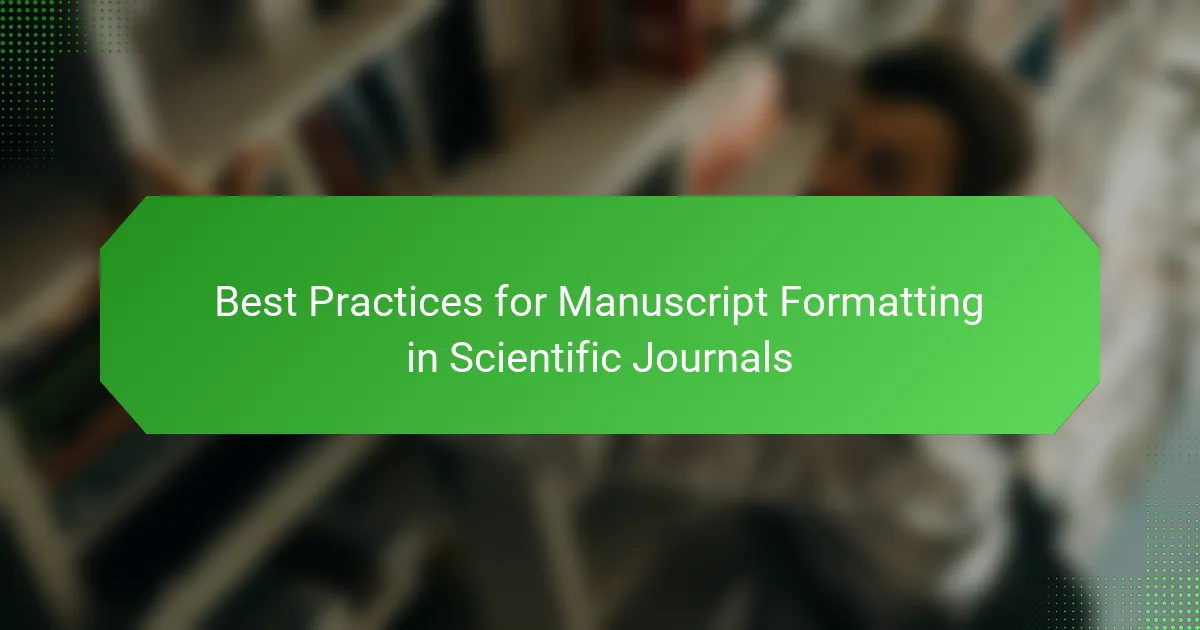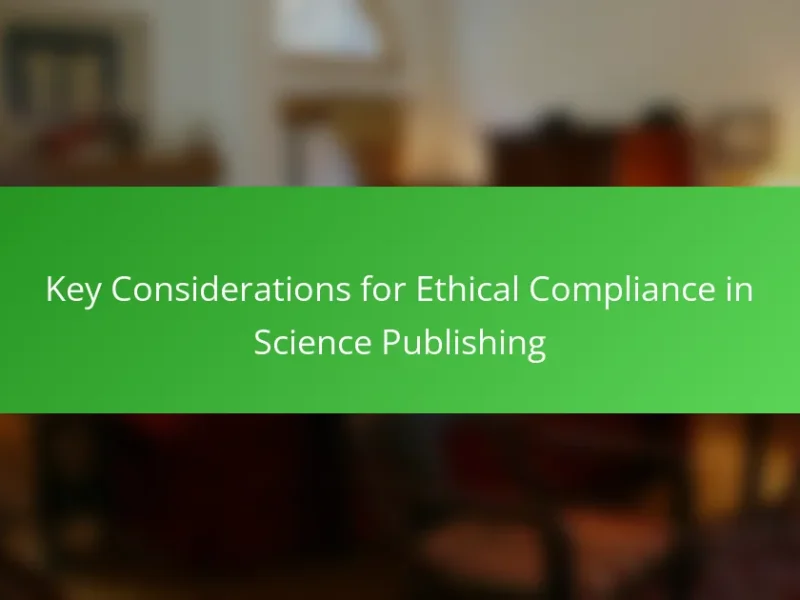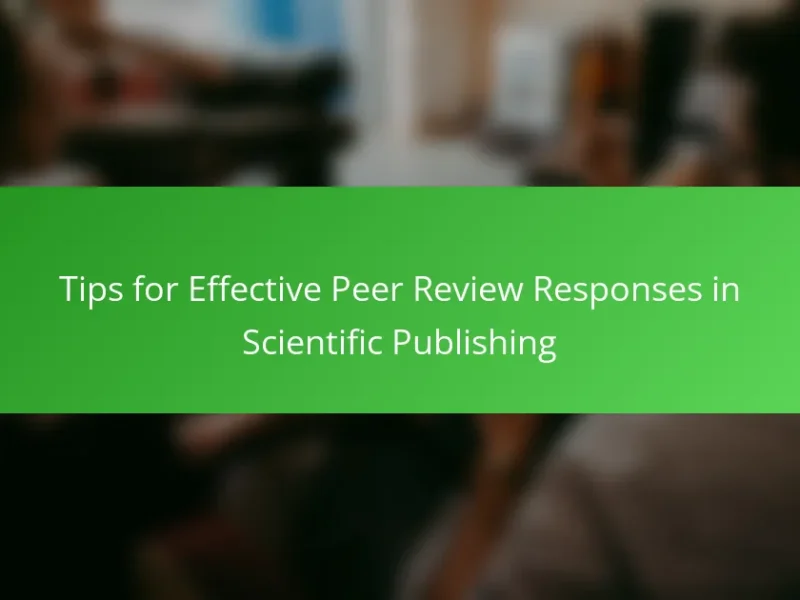Best practices for manuscript formatting in scientific journals emphasize the importance of adhering to specific guidelines established by each journal. Key elements include structured sections such as abstract, introduction, methods, results, and discussion, all clearly labeled and logically organized. Authors should use standard fonts like Times New Roman or Arial in size 12, maintain double-spacing, and ensure tables and figures are properly referenced. Consistency in formatting and adherence to citation styles, such as APA or MLA, are crucial for enhancing readability and increasing the likelihood of publication acceptance. Proofreading for grammar and clarity is also essential prior to submission.

What are the best practices for manuscript formatting in scientific journals?
The best practices for manuscript formatting in scientific journals include adhering to specific guidelines set by each journal. Authors should carefully review the journal’s submission guidelines prior to formatting. Common elements include structured sections such as abstract, introduction, methods, results, and discussion. Each section should be clearly labeled and organized logically.
Text should be double-spaced with standard margins. Fonts like Times New Roman or Arial in size 12 are typically preferred. Tables and figures must be clearly labeled and referenced within the text. Citations should follow the journal’s specified style, such as APA or MLA.
Proofreading for grammar and clarity is essential before submission. Consistency in formatting throughout the manuscript enhances readability. Following these practices increases the likelihood of acceptance for publication.
Why is manuscript formatting important in scientific publishing?
Manuscript formatting is crucial in scientific publishing because it ensures clarity and consistency. Properly formatted manuscripts facilitate easier review and comprehension by editors and reviewers. Adherence to specific guidelines enhances the likelihood of acceptance for publication. Many journals have particular formatting requirements that reflect their standards. For example, a study published in the Journal of Scholarly Publishing emphasizes that uniformity in formatting aids in maintaining the quality of published research. Additionally, well-structured manuscripts improve the reader’s experience, allowing for efficient navigation of content. Therefore, manuscript formatting is a fundamental aspect of the scientific communication process.
How does proper formatting influence peer review outcomes?
Proper formatting significantly influences peer review outcomes by enhancing readability and comprehension. Well-formatted manuscripts allow reviewers to easily navigate through sections. This clarity helps them assess the study’s methodology and findings more effectively. For instance, consistent use of headings and subheadings organizes content logically. A study published in the Journal of Scholarly Publishing found that manuscripts adhering to formatting guidelines received higher review scores. Reviewers are more likely to focus on the content rather than being distracted by poor formatting. This ultimately leads to a more favorable evaluation and increases the chances of acceptance for publication.
What role does formatting play in ensuring clarity and readability?
Formatting plays a crucial role in ensuring clarity and readability. Proper formatting organizes content logically. This organization helps readers navigate the text easily. Clear headings and subheadings guide the reader through sections. Consistent font styles and sizes enhance visual coherence. Adequate spacing between lines and paragraphs prevents crowding. Bullet points and numbered lists break complex information into digestible parts. Research shows that well-formatted documents improve comprehension and retention. A study by the American Psychological Association indicates that clarity in formatting directly affects reader engagement.
What are the common formatting guidelines across scientific journals?
Common formatting guidelines across scientific journals include specific requirements for font type and size, margin settings, and line spacing. Most journals prefer a standard font like Times New Roman or Arial, typically sized at 12 points. Margins are commonly set to one inch on all sides. Line spacing is often double-spaced for the main text, while single spacing may be used for references.
Additionally, scientific journals require structured sections such as an abstract, introduction, methods, results, and discussion. Each section should be clearly labeled. References must follow a specific citation style, which varies by journal, such as APA, MLA, or Chicago. Figures and tables have their own guidelines regarding labeling and placement within the manuscript.
These formatting guidelines ensure consistency and clarity, making it easier for reviewers and readers to navigate the content. Adhering to these standards is crucial for successful manuscript submission and publication.
What are the typical sections required in a scientific manuscript?
A scientific manuscript typically includes several essential sections. These sections are Title, Abstract, Introduction, Methods, Results, Discussion, and References.
The Title provides a concise description of the research. The Abstract summarizes the main findings and significance. The Introduction outlines the research question and context. The Methods section details the experimental procedures and materials used. The Results present the data and findings of the study. The Discussion interprets the results and their implications. Finally, the References list all sources cited in the manuscript.
These sections are standard across most scientific journals, ensuring clarity and consistency in scientific communication.
How do citation and reference styles vary among journals?
Citation and reference styles vary significantly among journals. Each journal may adopt a specific style guide, such as APA, MLA, Chicago, or Vancouver. These styles dictate how to format in-text citations and the reference list. For example, APA uses the author-date system, while MLA employs a parenthetical citation format. Some journals may require footnotes or endnotes instead of in-text citations. Additionally, the order of authors, publication years, and the inclusion of DOIs can differ. Journals often provide detailed guidelines for authors to ensure compliance with their preferred style. Following these guidelines is crucial for manuscript acceptance.
What specific formatting requirements should authors be aware of?
Authors should be aware of several specific formatting requirements when preparing manuscripts for submission to scientific journals. These requirements typically include font type and size, margin specifications, and line spacing. Commonly, journals require a standard font like Times New Roman or Arial, sized at 12 points. Margins are often set to 1 inch on all sides. Line spacing is typically double-spaced to enhance readability.
Additionally, authors should follow specific guidelines for section headings, figures, and tables. For instance, headings may need to be bolded or italicized according to the journal’s style. Figures and tables usually require captions and must be referenced in the text.
Citations and references must adhere to a particular style, such as APA or MLA, as specified by the journal. Many journals provide detailed formatting guidelines in their submission instructions. Adhering to these requirements is crucial for successful manuscript submission and review.
What font types and sizes are generally recommended?
Recommended font types include Times New Roman, Arial, and Calibri. A common font size is 12 points for the main text. For headings, sizes may vary from 14 to 16 points. These choices enhance readability and professionalism in manuscripts. Many scientific journals specify these fonts and sizes in their submission guidelines. Following these recommendations ensures compliance with standard formatting practices.
How should authors structure headings and subheadings?
Authors should structure headings and subheadings hierarchically. Main headings should be clear and concise, typically formatted in bold or larger font. Subheadings should provide specific details related to the main heading and follow a consistent style. Authors should use a logical order, starting from broad topics and narrowing down to specific points. Each level of heading should be distinct to enhance readability. For example, primary headings may use title case, while subheadings can use sentence case. Consistency in formatting across the manuscript is essential. This structure improves navigation and helps readers locate information efficiently.
How can authors ensure adherence to journal-specific formatting?
Authors can ensure adherence to journal-specific formatting by carefully reviewing the journal’s submission guidelines. Each journal provides detailed instructions on formatting requirements. These may include font type, size, margin settings, and citation style. Authors should also utilize templates provided by the journal, if available. Templates can simplify the formatting process significantly. Additionally, authors can use reference management software to maintain consistency in citations and references. Double-checking the manuscript against the journal’s checklist before submission is crucial. This practice helps catch any formatting errors that may have been overlooked. Following these steps increases the likelihood of a smooth submission process.
What tools and resources are available for manuscript formatting?
Tools and resources for manuscript formatting include software applications and online services. Popular software includes LaTeX, which is widely used for technical documents. Microsoft Word offers built-in templates for various journals. Reference management tools like EndNote and Zotero assist in formatting citations. Online platforms such as Overleaf provide collaborative editing features for LaTeX documents. Many journals offer specific guidelines and templates on their websites. These resources help ensure compliance with formatting standards.
How can formatting software assist in meeting journal guidelines?
Formatting software can streamline the process of meeting journal guidelines. It automates the application of specific formatting styles required by journals. This includes adjustments to margins, font sizes, and reference styles. Formatting software also helps in organizing sections according to journal requirements. Many programs offer templates that align with various journal specifications. This reduces the risk of human error during formatting. Additionally, some software can check for compliance with citation rules. Overall, these tools save time and enhance accuracy in manuscript preparation.
What templates are commonly used for scientific manuscripts?
Common templates used for scientific manuscripts include those provided by major journals. These templates typically follow specific formatting guidelines for structure and style. For example, the American Psychological Association (APA) style is widely used in social sciences. The Modern Language Association (MLA) style is common in humanities research. The American Medical Association (AMA) style is standard in medical publications. Additionally, many journals offer their own customized templates. These templates often include sections for abstract, introduction, methods, results, and discussion. Using the correct template helps ensure compliance with journal submission requirements.
What are some common pitfalls to avoid in manuscript formatting?
Common pitfalls to avoid in manuscript formatting include inconsistent font usage, incorrect margins, and improper citation styles. Inconsistent font usage can distract readers and detract from professionalism. Incorrect margins may lead to text being cut off during printing or digital publication. Improper citation styles can result in rejection from journals that have specific formatting guidelines. Additionally, neglecting to include necessary sections, such as abstracts or keywords, can lead to incomplete submissions. Failing to adhere to journal-specific guidelines is a frequent issue that can hinder acceptance. Finally, overlooking proofreading can result in typographical errors that undermine credibility.
How can inconsistent formatting affect manuscript submission?
Inconsistent formatting can lead to manuscript rejection. Many journals have strict formatting guidelines. Non-compliance with these guidelines can create a negative impression. Reviewers may perceive the manuscript as unprofessional. This perception can affect their evaluation of the research quality. A study by the Committee on Publication Ethics found that formatting errors are a common reason for initial rejections. Proper formatting helps ensure clarity and readability. Consistent formatting also aids in maintaining a professional standard across submissions.
What are the consequences of ignoring journal-specific guidelines?
Ignoring journal-specific guidelines can lead to manuscript rejection. Journals have specific formatting rules to ensure consistency and clarity. Failure to adhere to these guidelines often results in a lack of professionalism. This can negatively impact the perceived quality of the research. Additionally, ignoring guidelines may cause delays in the review process. Reviewers may find it challenging to evaluate improperly formatted submissions. In some cases, authors may miss out on publication opportunities entirely. A study from the Journal of Scholarly Publishing indicates that adherence to formatting guidelines increases acceptance rates significantly.
What practical tips can enhance manuscript formatting success?
To enhance manuscript formatting success, follow established guidelines from target journals. Adhere to specified font types and sizes, typically Times New Roman, 12-point. Use consistent line spacing, often double-spaced, for readability. Implement proper margins, usually one inch on all sides. Organize sections with clear headings and subheadings as per journal requirements. Include a title page with essential information like authors and affiliations. Maintain consistent citation styles throughout the manuscript, such as APA or MLA. Utilize templates provided by journals to ensure compliance with formatting standards. Finally, proofread for grammatical accuracy and formatting consistency before submission.
The main entity of the article is ‘manuscript formatting in scientific journals.’ This article outlines best practices for authors to follow when preparing manuscripts for submission, emphasizing the importance of adhering to specific journal guidelines. Key topics include essential formatting elements such as structured sections, font types, citation styles, and the significance of consistency in enhancing readability and acceptance rates. Additionally, the article addresses common pitfalls to avoid and practical tips for successful manuscript formatting, ensuring clarity and professionalism in scientific communication.


